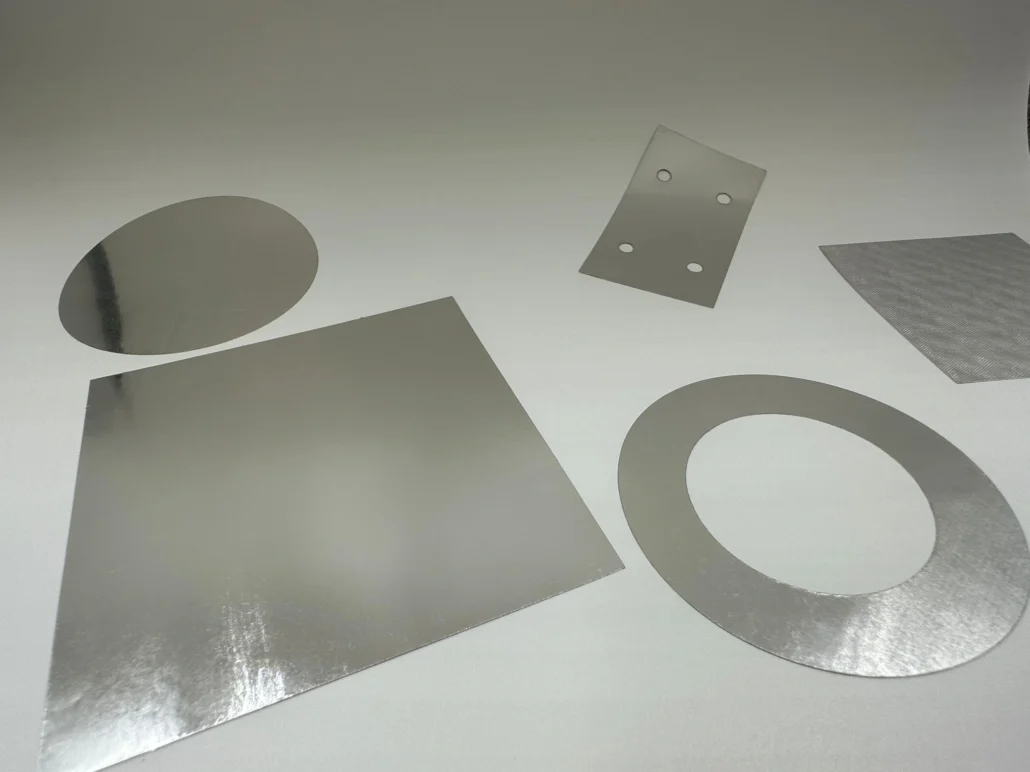Indium tyhjiötiiviste erottuu erinomaisesta materiaalista heliumtiiviiden hermeettisten tiivisteiden luomiseen, metallien ja ei-metallisten alustojen, kuten lasin ja keramiikan, yhdistämiseen. Sen monipuolisuus ulottuu kryogeenisiin ympäristöihin, tyhjiöpumppuihin ja lämpöherkkään alueeseen, missä se varmistaa luotettavan suojan.
Kun indium toimii tiivisteaineena, se aloittaa kemiallisen sidoksen liittämiensä pintojen kanssa, mikä eroaa pelkästä muiden tiivistemateriaalien muodostamasta esteestä. Erityisesti indiumtiivisteet osoittavat kestävyyttä mekaanisia iskuja, tärinää ja äärimmäisiä lämpötiloja vastaan, joten ne ovat välttämättömiä vaativissa sovelluksissa.
Indiumin luontainen ominaisuus on sen taipumus muodostaa oksidikalvo sen pinnalle. Koskemattoman sidoksen muodostamiseksi alustan kanssa tämä kalvo on hajotettava puristuksen ja plastisen muodonmuutoksen avulla. Tämä prosessi, jota helpottaa indiumin muokattavuus, tapahtuu helposti jopa kryogeenisissä lämpötiloissa, mikä varmistaa tehokkaan tiivistyksen.
Laatu an indium tiiviste riippuu useista tekijöistä:
- Puhtaus ja puhtaus: Optimaaliset indiumin puhtaustasot 99.99% ovat suositeltavia, vaikka tietyt sovellukset vaativat 99.999% indiumin puhtautta. Epäpuhtaudet, erityisesti orgaaniset yhdisteet, tulee poistaa rasvanpoistolla. Pintaoksidit voidaan poistaa kastamalla lyhyesti 50% suolahappoon ja huuhtelemalla sen jälkeen deionisoidussa vedessä.
- Pinnan esikäsittely: Kaikki pinnat on puhdistettava ja kuivattava perusteellisesti. Lasi- ja keraamiset pinnat vaativat kromi- ja rikkihapokäsittelyn, jonka jälkeen kloorivetyhapolla ja deionisoidulla vedellä huuhtelevat. Indium Metallipinnat voivat olla paljaita, esitinattuja indiumilla tai pinnoitettu indiumilla tai hopealla. Pinnan viimeistely tulee suorittaa huolellisesti, ilman liiallista kiillotusta tai hankaavia muutoksia.
- Indiumin paksuus ja muoto: Indium Tiivisteen paksuus vaihtelee pinta-alan ja puristusvoiman mukaan. Indium O-rengasurasovelluksissa indiumtiivisteen tulee ylittää uran mitat 5-15% puristettuna. Päällekkäiset indiumsegmentit voivat korvata jatkuvan pesun tietyissä skenaarioissa. Hyvin muotoiltujen tiivisteiden vuotonopeus on alle 2 x 10-7 torr x litra/s.
Noudattamalla huolellisia menetelmiä indiumin valinnassa, pinnan valmistelussa ja tiivistekokoonpanossa insinöörit voivat varmistaa hermeettisten tiivisteiden luotettavuuden ja tehokkuuden kriittisissä sovelluksissa.

Fyysiset ominaisuudet
Yksi merkittävimmistä fysikaalisista ominaisuuksista indium on sen poikkeuksellinen taipuisuus ja muokattavuus. Indiumin Mohs-kovuus on vain 1,2, mikä on huomattavasti pienempi kuin kuparin (2,5-3) ja alumiinin (2-2,9), joten se on paljon pehmeämpi ja helpompi muotoilla.
Sen sulamispiste on suhteellisen alhainen, 156,6 °C, joten se voidaan helposti muovata eri muotoisiksi ja kokoisiksi, kuten esimuotiksi ja lankoiksi, sopimaan tiettyihin tiivistyssovelluksiin.
Indium voidaan valmistaa paksuuksiksi, jotka vaihtelevat ohuesta (0,008 tuumaa) paksuun (0,062 tuumaa) liitospintojen ja tarvittavien puristusvoimien mukaan.
Kemialliset ominaisuudet
Tiivistysominaisuudet
IndiumSen kyky muodostaa hermeettisiä tiivisteitä ilman lämmön tarvetta on erityisen edullinen ympäristöissä, joissa lämpö tai juotosvuote voi aiheuttaa ongelmia, kuten kaasun poistumisen.
Tiivisteaineena käytettynä indium käynnistää kemiallisen sidoksen liittämiensä pintojen kanssa, mikä tarjoaa erinomaiset tiivistysominaisuudet verrattuna muihin tiivistemateriaaleihin, jotka toimivat vain esteinä.
Tämän ominaisuuden ansiosta indiumtiivisteet voivat säilyttää eheytensä jopa mekaanisissa iskuissa, tärinässä ja äärimmäisissä lämpötiloissa, joten ne ovat välttämättömiä vaativissa sovelluksissa.
Pinnan esikäsittely
Pinnan asianmukainen esikäsittely on erittäin tärkeää korkealaatuisten indiumtiivisteiden saavuttamiseksi. Pinnat on puhdistettava ja kuivattava perusteellisesti eri materiaaleille tarkoitetuilla erityiskäsittelyillä. Esimerkiksi lasi- ja keraamiset pinnat tulee käsitellä kromi- ja rikkihapolla, jonka jälkeen huuhdellaan kloorivetyhapolla ja deionisoidulla vedellä.
Indium metalli pinnat saattavat vaatia esitinaamista tai pinnoitusta indiumilla tai hopealla optimaalisen kiinnityksen varmistamiseksi.
Pintaoksidien poistamista puristuksen ja plastisen muodonmuutoksen kautta helpottaa indiumin muokattavuus, mikä varmistaa tehokkaan tiivistyksen myös kryogeenisissä lämpötiloissa.
Indiumin monipuolisuus ulottuu sen käyttöön heliumtiiviiden hermeettisten tiivisteiden muodostamisessa, jotka pystyvät yhdistämään metalleja ja ei-metallisia substraatteja, kuten lasia ja keramiikkaa. Tämä tekee indiumista välttämättömän materiaalin sovelluksissa, joissa vaaditaan luotettavaa suorituskykyä tyhjiöpumpuissa, kryogeenisissa ympäristöissä ja muilla lämpöherkillä alueilla.
Indium tyhjiötiivistystekniikka
Indium tyhjiötiivistystekniikka hyödyntää indiumin ainutlaatuisia ominaisuuksia luoden luotettavia ja tehokkaita tiivisteitä useissa eri sovelluksissa, mukaan lukien kryogeeniset ympäristöt, tyhjiöpumput ja lämpöherkät alueet.
Tätä tekniikkaa arvostetaan erityisesti sen kyvystä muodostaa heliumtiiviitä hermeettisiä tiivisteitä, jotka yhdistävät sekä metallisia että ei-metallisia alustoja, kuten lasia ja keramiikkaa.
Ominaisuudet ja edut
Indium on ominaista sen alhainen sulamispiste, hyvä muokattavuus ja sitkeys, mikä tekee siitä ihanteellisen materiaalin tyhjiötiivistykseen.
Toisin kuin muista materiaaleista valmistetut tiivisteet, jotka muodostavat vain esteen, indium muodostaa kemiallisen sidoksen liittämiensä pintojen kanssa, mikä parantaa tiivisteen kestävyyttä mekaanisia iskuja, tärinää ja alhaisia lämpötiloja vastaan.
Indiumin merkittävä ominaisuus on sen taipumus kehittää oksidikalvo sen pinnalle. Koskemattoman sidoksen muodostamiseksi alustan kanssa tämä oksidikalvo on hajotettava puristamalla ja plastisella muodonmuutoksella, jota metallin muokattavuus helpottaa.
Tämä varmistaa tehokkaan tiivistyksen myös kryogeenisissa lämpötiloissa ilman lämmön tarvetta.
Sovellukset
Indium tyhjiötiivisteet niillä on laaja valikoima sovelluksia ainutlaatuisten ominaisuuksiensa ja kykynsä ansiosta toimia tehokkaasti äärimmäisissä olosuhteissa. Indiumtiivisteiden monipuolisuus tekee niistä sopivia ilmailu- ja autoteollisuudesta lääketieteen ja teollisuuden aloille.
Ilmailu ja autoteollisuus
Ilmailu- ja autoteollisuudessa indiumtiivisteitä käytetään niiden erinomaisten tiivistysominaisuuksiensa ja niiden kyvyn vuoksi ylläpitää tyhjiöä korkean paineen ja korkean lämpötilan olosuhteissa. Tämä varmistaa ankarissa ympäristöissä toimivien komponenttien ja järjestelmien eheyden.
Lääketieteellinen ja teollinen
Indiumtyhjiötiivisteiden lääketieteelliset ja teolliset sovellukset ovat laajat. Indiumtiivisteitä käytetään lääketieteellisissä laitteissa ja laitteissa, jotka vaativat korkeaa puhtautta ja luotettavuutta, kuten diagnostisissa työkaluissa ja bioimplanteissa. Esimerkiksi henkilökohtainen lääketiede ja hoitopistediagnostiikka (POC) perustuvat usein molekyylitasolla toimiviin laitteisiin, joissa tiivisteiden tarkka toiminta on ratkaisevaa.
Älykkään teknologian integrointi
Kasvava trendi indium-tiiviste on älykkään teknologian integrointi. Esineiden internetin (IoT) laajentuessa on kysyntää tiivistysratkaisuille, joilla voidaan seurata ja ohjata erilaisia prosesseja reaaliajassa. Indiumtiivisteet sopivat hyvin näihin sovelluksiin ainutlaatuisten ominaisuuksiensa ansiosta, joten niitä voidaan käyttää monenlaisissa skenaarioissa. Sisällyttämällä antureita ja muita älykkäitä laitteita indiumtiivisteisiin valmistajat voivat luoda tehokkaampia ja älykkäämpiä tiivistysratkaisuja.
Pinta-analyysitekniikat
Ultra-high vacuum (UHV) -sovelluksissa indiumtiivisteet ovat kriittisiä pinta-analyyttisten tekniikoiden edellyttämien tyhjiöolosuhteiden ylläpitämisessä. Näihin tekniikoihin kuuluvat röntgenfotoelektronispektroskopia (XPS), Auger-elektronispektroskopia (AES), sekundaari-ionimassaspektrometria (SIMS) ja muut. UHV-olosuhteet ovat välttämättömiä pintakontaminaation vähentämiseksi näiden analyysien aikana. Indiumtiivisteet auttavat saavuttamaan tiukat tyhjiöolosuhteet, jotka vaaditaan näissä erittäin tarkoissa tekniikoissa, mikä mahdollistaa tarkat ja luotettavat mittaukset.
Uusia teknologioita
Kehittyvät teknologiat, kuten kiinnittymisenesto-ominaisuudet, bioimplantit ja diagnostiset laitteet, hyötyvät myös indium tyhjiötiivisteet. Nämä sovellukset edellyttävät perustavanlaatuista ymmärrystä biorajapinnoista ja kykyä ylläpitää steriilejä ja saasteista vapaita ympäristöjä. Indiumtiivisteet edistävät merkittävästi näitä kenttiä tarjoamalla luotettavia tiivistysratkaisuja, jotka täyttävät nykyaikaisen tekniikan tiukat vaatimukset.
Yhteenveto
An indium tyhjiötiiviste on erikoistunut tiivistystekniikka, joka hyödyntää indiumin ainutlaatuisia ominaisuuksia, siirtymän jälkeistä metallia, joka tunnetaan muokattavuudestaan, taipuisuudestaan ja kyvystään muodostaa hermeettisiä tiivisteitä. Indium-tyhjiötiivisteet ovat erittäin arvostettuja niiden kyvystä muodostaa heliumtiiviitä hermeettisiä tiivisteitä sitoutumalla kemiallisesti pintoihin, joita ne yhdistävät. Tämä kemiallinen sidos, sen sijaan että se toimisi vain esteenä, varmistaa erinomaiset tiivistysominaisuudet, jotka kestävät mekaanisia iskuja, tärinää ja äärimmäisiä lämpötiloja.
